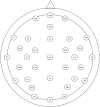Can the error detection mechanism benefit from training the working memory? A comparison between dyslexics and controls--an ERP study
- PMID: 19779625
- PMCID: PMC2746314
- DOI: 10.1371/journal.pone.0007141
Can the error detection mechanism benefit from training the working memory? A comparison between dyslexics and controls--an ERP study
Abstract
Background: Based on the relationship between working memory and error detection, we investigated the capacity of adult dyslexic readers' working memory to change as a result of training, and the impact of training on the error detection mechanism.
Methodology: 27 dyslexics and 34 controls, all university students, participated in the study. ERP methodology and behavioral measures were employed prior to, immediately after, and 6 months after training. The CogniFit Personal Coach Program, which consists of 24 sessions of direct training of working memory skills, was used.
Findings: Both groups of readers gained from the training program but the dyslexic readers gained significantly more. In the dyslexic group, digit span increased from 9.84+/-3.15 to 10.79+/-3.03. Working memory training significantly increased the number of words per minute read correctly by 14.73%. Adult brain activity changed as a result of training, evidenced by an increase in both working memory capacity and the amplitude of the Error-related Negativity (ERN) component (24.71%). When ERN amplitudes increased, the percentage of errors on the Sternberg tests decreased.
Conclusions: We suggest that by expanding the working memory capacity, larger units of information are retained in the system, enabling more effective error detection. The crucial functioning of the central-executive as a sub-component of the working memory is also discussed.
Conflict of interest statement
Figures


References
-
- Breznitz Z. Mahwah, NJ, USA: Lawrence Elbaum and Associates; 2006. Fluency in reading: Sychronization of processes.
-
- British Psychological Society. Leicester, UK: British Psychological Society; 1999. Dyslexia, literacy and psychological assessment.
-
- Landerl K, Wimmer H, Frith U. The impact of orthographic consistency on dyslexia: A German-English comparison. Cognition. 1997;63:215–334. - PubMed
-
- Thomson M. A psycholinguistic analysis of reading errors made by dyslexics and normal readers. J Resh Reading. 1978;1:7–20.
-
- Falkenstein M, Hohnsbein J, Hoormann J, Blanke L. Effects of crossmodal divided attention on late ERP components. II. Error processing in choice reaction tasks. EEG Clin Neurophysiol. 1991;78:447–455. - PubMed
Publication types
MeSH terms
LinkOut - more resources
Full Text Sources

